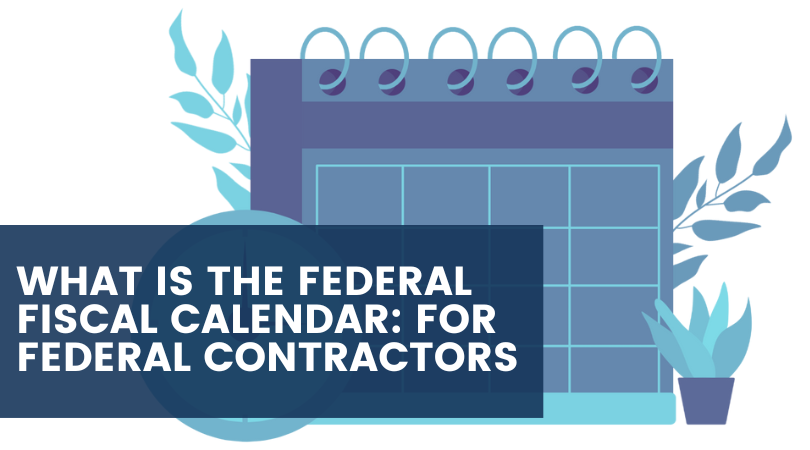
As a federal contractor or an aspiring one, you have probably heard the words “Federal Fiscal Calendar” floating around. You may be wondering why this matters to you or what real effects it has on contractors.
Utilizing our over ten years of experience, we’ll break down why you should care about the federal fiscal calendar and how it will affect your business as a contractor.
Here’s an overview of what this post will be covering:
- History of the Fiscal Calendar
- The Annual Budget
- What this Means for Federal Contractors
- Key Takeaways from the Proposed 2023 Budget
Let’s start with the…
History of the Fiscal Calendar
I’m sure you are already familiar with a fiscal year – the period of time used for accounting purposes. The US Federal Government’s fiscal year begins on October 1st and lasts through September 30th of the next calendar year.
The federal fiscal year was set in section 237 in the Revised States (R.S.§237) by an Act from the 43rd Congress in 1873 “to revise and consolidate the statutes of the United States, in force on the first day of December, anno Domini.”
At that time, the fiscal year was set to begin on July 1 of each year. In 1974, Title V of the Congressional Budget Act was signed into law and changed the fiscal year to begin on October 1st of each year.
Why the Federal Fiscal Year Starts in October: A Look Back at History
The federal fiscal year is the time period in which the annual budget must be spent.
The Annual Budget
Every year, Congress has to approve the budget for the next fiscal year. The annual budget is first proposed by the executive branch, though.
The president should submit a proposed budget to Congress by the first Monday in February every year, and then Congress, which the Constitution puts in charge of spending and borrowing, starts its work.
The annual budget covers three spending areas:
- Discretionary spending (or Federal agency funding)—the area Congress sets annually. Discretionary spending typically accounts for around a third of all funding.
- Interest on the debt, which usually uses less than 10 percent of all funding
- Mandatory spending includes funding for Social Security, Medicare, veterans benefits, and other spending required by law. This typically uses over half of all funding.
Congress then must pass appropriations bills based on the president's recommendations and Congressional priorities to determine discretionary spending.
Once Congress agrees on the budget in the form of a concurrent resolution (a resolution that does not need approval by the executive branch), the budget is circulated to governmental agencies in order to be enacted.
As I’m sure we are all familiar with, if Congress does not approve the budget by the start of the fiscal year, there will then be a government shutdown.
Congress will then enact a continuing resolution to keep the government running until an annual budget can be established.
What this Means for Federal Contractors
Now, as a federal contractor, why should the federal fiscal calendar matter for you?
Well, the US Government historically spends the most money on federal contracts during the first and last quarter of the fiscal year. Meaning, that during the months of July to December, there are a lot of opportunities available for federal contractors.
Let’s take a look at the number of contracts awarded in the last quarter of the 2021 fiscal year. There were a total of 1,627,009 awards. In the first quarter of the 2022 fiscal year, there were 1,354,288 contracts awarded.
To put these numbers into perspective, there were 774,285 contracts awarded in the second quarter of the 2022 fiscal year. That’s 53% and 43% less than the amounts awarded in the last quarter of 2021 and the first quarter of 2022!
This data was pulled from the Advanced Procurement Portal (APP).
The numbers don’t lie. If you haven’t been able to find bids or you want to get started in federal contracting, now is the time.
Key Takeaways From the 2023 Budget
On March 28, 2022, the Biden-Harris Administration submitted its proposed budget to Congress for the 2023 fiscal year. Here are some major areas in the proposal that may provide a great opportunity for federal contractors:
- $773.0 billion for the Department of Defense (DoD)
- $88.3 billion for the Department of Education's (ED)
- $59.5 billion for the Federal Highway Administration (FHWA)
- $18.6 billion for the Federal Aviation Administration (FAA)
- $2.7 billion for Wild Fire Management Activities
- $36.2 million to support the national information and communication technology and services (ICTS) supply chain
- $275 million for the Hollings Manufacturing Extension Partnership (MEP)
- $200 million for a Solar Manufacturing Accelerator
- $120 million for NIST construction of research facilities to address the major utility infrastructure maintenance backlog and modernize and upgrade IT networks
This is just a sample of the possible funding available to contractors.
Currently, in APP, there are over 5 million opportunities available to contractors, and starting in July (and on to December), we expect to see an increase of up to 25%.
If you want access to these contracts, we recommend that you register or renew your System for Award Management (SAM) as soon as possible.
If you need help with the registration or renewal process, our team of experts at USFCR has a proven track record, assisting with over 300,000 compliant SAM registrations.
Trust in USFCR to help you succeed in the federal marketplace. To speak with a Registration and Contracting Specialist, Call:




